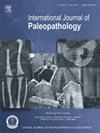Play or foul play: A case of perimortem cranial injuries on a child from Yaoheyuan, Western Zhou China (1046–771 BCE)
IF 1.5
3区 地球科学
Q3 PALEONTOLOGY
引用次数: 0
Abstract
Objective
This paper evaluates evidence of trauma observed on a skeleton of a child from Ningxia, China in order to assess the potential cause of the lesions.
Materials
Skeletonized remains of Individual M26:R3 from the site of Yaoheyuan in Western Zhou, dated 1046–771 BCE.
Methods
Standard osteological methods were carried out. Nano-CT scans were used to determine possible endocranial trauma and to reconstruct the crania. Ancient DNA analysis was conducted on the remains of the three individuals interred in burial M26 to determine possible kinship relationships.
Results
A total of 59 individuals were studied. The individual under examination was a male with an estimated age of 6–9 years old. The child was found alongside two adult females. The osteological analysis and CT scans indicated two perimortem injuries and one possible perimortem sharp force cutmark on his cranium. Ancient DNA analysis performed on the three individuals in burial M26 revealed no familial relatedness.
Conclusions
The multiple strike marks on the remains of the child, along with the fact that he was the only individual in this burial ground showing clear evidence of sharp force cranial injuries, might suggest a unique incident of violence.
Significance
This paper demonstrates how the integration of osteoarchaeological observation with ancient DNA analysis can provide insight and contextualization of perimortem events.
Limitations
Post-depositional disturbance affecting the archaeological contexts of this cemetery complicates the interpretation of this case.
Suggestions for future research
Systematic archaeological and historical data are needed to understand reasons behind violent episodes in ancient China.
玩还是犯规:中国西周(公元前1046-771年)尧河源一名儿童死前颅脑损伤案例。
目的:对中国宁夏一儿童骨骼上观察到的创伤证据进行评估,以评估损伤的潜在原因。资料:公元前1046-771年西周姚河源遗址出土的M26:R3个体骨架遗骸。方法:采用标准骨学方法。纳米ct扫描用于确定可能的颅内创伤和重建颅骨。对M26号墓葬中埋葬的三个人的遗骸进行了古代DNA分析,以确定可能的亲属关系。结果:共研究了59例个体。接受检查的个体是一名男性,估计年龄为6-9岁。这名儿童和两名成年女性一起被发现。骨学分析和CT扫描显示有两处死前伤颅骨上可能有一处死前锐器刻痕。对埋葬M26的三个人进行的古代DNA分析显示没有家族关系。结论:孩子尸体上的多处击打痕迹,加上他是这片墓地里唯一一个有明显利器颅脑损伤证据的人,可能表明这是一起独特的暴力事件。意义:本文展示了骨考古观察与古代DNA分析的结合如何为死前事件提供见解和背景。限制:沉积后的扰动影响了这个墓地的考古背景,使这个案例的解释复杂化。对未来研究的建议:需要系统的考古和历史资料来了解中国古代暴力事件背后的原因。
本文章由计算机程序翻译,如有差异,请以英文原文为准。
求助全文
约1分钟内获得全文
求助全文
来源期刊

International Journal of Paleopathology
PALEONTOLOGY-PATHOLOGY
CiteScore
2.90
自引率
25.00%
发文量
43
期刊介绍:
Paleopathology is the study and application of methods and techniques for investigating diseases and related conditions from skeletal and soft tissue remains. The International Journal of Paleopathology (IJPP) will publish original and significant articles on human and animal (including hominids) disease, based upon the study of physical remains, including osseous, dental, and preserved soft tissues at a range of methodological levels, from direct observation to molecular, chemical, histological and radiographic analysis. Discussion of ways in which these methods can be applied to the reconstruction of health, disease and life histories in the past is central to the discipline, so the journal would also encourage papers covering interpretive and theoretical issues, and those that place the study of disease at the centre of a bioarchaeological or biocultural approach. Papers dealing with historical evidence relating to disease in the past (rather than history of medicine) will also be published. The journal will also accept significant studies that applied previously developed techniques to new materials, setting the research in the context of current debates on past human and animal health.
 求助内容:
求助内容: 应助结果提醒方式:
应助结果提醒方式:


